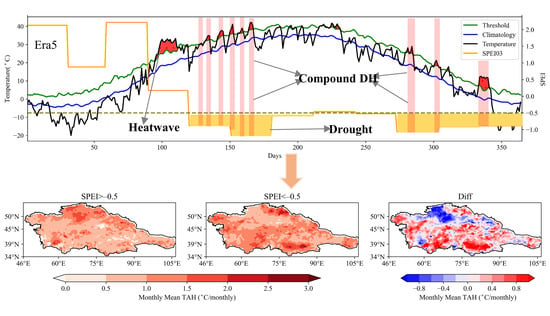Increased Compound Droughts and Heatwaves in a Double Pack in Central Asia
Abstract
:1. Introduction
2. Materials and Methods
2.1. Study Area
2.2. Data Sources
2.2.1. ERA5-Land Hourly Data
2.2.2. SPEI Data
2.2.3. Other Data
2.3. Methods
2.3.1. Evaluation of Heatwave Events and Drought Events
2.3.2. Evaluation of Heatwave–Drought Compounds
2.3.3. Statistical Methods
3. Results
3.1. Spatio-Temporal Variations of Compound Events in Central Asia
3.2. Modal Analysis of Compound Events in Central Asia
3.3. Comparative Analysis of CDHW Intensity and Single Heatwave Events
3.4. Relationship of CDHWs to Drought and Heatwave Events
4. Discussion
5. Conclusions
Author Contributions
Funding
Data Availability Statement
Conflicts of Interest
References
- Masson-Delmotte, V.; Zhai, A.P.; Pirani, S.L.; Connors, C.; Péan, S.; Berger, N.; Caud, Y.; Chen, L.; Goldfarb, M.I.; Gomis, M.; et al. (Eds.) IPCC, 2021: Climate Change 2021: The Physical Science Basis. Contribution of Working Group I to the Sixth Assessment Report of the Intergovernmental Panel on Climate Change; Cambridge University Press: Cambridge, UK, 2021. [Google Scholar]
- Beringer, J.; Moore, C.E.; Cleverly, J.; Campbell, D.I.; Cleugh, H.; De Kauwe, M.G.; Kirschbaum, M.U.F.; Griebel, A.; Grover, S.; Huete, A.; et al. Bridge to the future: Important lessons from 20 years of ecosystem observations made by the OzFlux network. Glob. Chang. Biol. 2022, 28, 3489–3514. [Google Scholar] [CrossRef] [PubMed]
- Rodrigues, R.R.; Taschetto, A.S.; Sen Gupta, A.; Foltz, G.R. Common cause for severe droughts in South America and marine heatwaves in the South Atlantic. Nat. Geosci. 2019, 12, 620–626. [Google Scholar] [CrossRef]
- Alimonti, G.; Mariani, L.; Prodi, F.; Ricci, R.A. A critical assessment of extreme events trends in times of global warming. Eur. Phys. J. Plus 2022, 137, 112. [Google Scholar] [CrossRef]
- Guerreiro, S.B.; Dawson, R.J.; Kilsby, C.; Lewis, E.; Ford, A. Future heat-waves, droughts and floods in 571 European cities. Environ. Res. Lett. 2018, 13, 034009. [Google Scholar] [CrossRef]
- Lyon, B. Southern Africa Summer Drought and Heat Waves: Observations and Coupled Model Behavior. J. Clim. 2009, 22, 6033–6046. [Google Scholar] [CrossRef]
- Mazdiyasni, O.; AghaKouchak, A. Substantial increase in concurrent droughts and heatwaves in the United States. Proc. Natl. Acad. Aci. USA 2015, 112, 11484–11489. [Google Scholar] [CrossRef]
- Heinicke, S.; Frieler, K.A.; Jagermeyr, J.; Mengel, M. Global gridded crop models underestimate yield responses to droughts and heatwaves. Environ. Res. Lett. 2022, 17, 044026. [Google Scholar] [CrossRef]
- Mukherjee, S.; Ashfaq, M.; Mishra, A.K. Compound Drought and Heatwaves at a Global Scale: The Role of Natural Climate Variability-Associated Synoptic Patterns and Land-Surface Energy Budget Anomalies. J. Geophys. Res. Atmos. 2020, 125, e2019JD031943. [Google Scholar] [CrossRef]
- Zhou, S.; Yuan, X. Upwind Droughts Enhance Half of the Heatwaves Over North China. Geophys. Res. Lett. 2022, 49, e2021GL096639. [Google Scholar] [CrossRef]
- Pascoa, P.; Gouveia, C.M.; Russo, A.; Ribeiro, A.F.S. Summer hot extremes and antecedent drought conditions in Australia. Int. J. Clim. 2022. [Google Scholar] [CrossRef]
- Brás, T.A.; Seixas, J.; Carvalhais, N.; Jägermeyr, J. Severity of drought and heatwave crop losses tripled over the last five decades in Europe. Environ. Res. Lett. 2021, 16, 065012. [Google Scholar] [CrossRef]
- Christian, J.I.; Basara, J.B.; Hunt, E.D.; Otkin, J.A.; Xiao, X. Flash drought development and cascading impacts associated with the 2010 Russian heatwave. Environ. Res. Lett. 2020, 15, 094078. [Google Scholar] [CrossRef]
- Libonati, R.; Geirinhas, J.L.; Silva, P.S.; Russo, A.; Rodrigues, J.A.; Belem, L.B.C.; Nogueira, J.; Roque, F.O.; DaCamara, C.C.; Nunes, A.M.B.; et al. Assessing the role of compound drought and heatwave events on unprecedented 2020 wildfires in the Pantanal. Environ. Res. Lett. 2022, 17, 015005. [Google Scholar] [CrossRef]
- Sharma, S.; Mujumdar, P. Increasing frequency and spatial extent of concurrent meteorological droughts and heatwaves in India. Sci. Rep. 2017, 7, 15582. [Google Scholar] [CrossRef] [PubMed]
- Bevacqua, E.; Zappa, G.; Lehner, F.; Zscheischler, J. Precipitation trends determine future occurrences of compound hot-dry events. Nat. Clim. Chang. 2022, 12, 350–355. [Google Scholar] [CrossRef]
- Tavakol, A.; Rahmani, V.; Harrington, J., Jr. Probability of compound climate extremes in a changing climate: A copula-based study of hot, dry, and windy events in the central United States. Environ. Res. Lett. 2020, 15, 104058. [Google Scholar] [CrossRef]
- Hoover, D.L.; Hajek, O.L.; Smith, M.D.; Wilkins, K.; Slette, I.J.; Knapp, A.K. Compound hydroclimatic extremes in a semi-arid grassland: Drought, deluge, and the carbon cycle. Glob. Chang. Biol. 2022, 28, 2611–2621. [Google Scholar] [CrossRef]
- Gouveia, C.M.; Bistinas, I.; Liberato, M.L.R.; Bastos, A.; Koutsias, N.; Trigo, R. The outstanding synergy between drought, heatwaves and fuel on the 2007 Southern Greece exceptional fire season. Agric. For. Meteorol. 2016, 218–219, 135–145. [Google Scholar] [CrossRef]
- Miralles, D.G.; Gentine, P.; Seneviratne, S.I.; Teuling, A.J. Land-atmospheric feedbacks during droughts and heatwaves: State of the science and current challenges. Ann. N. Y. Acad. Sci. 2019, 1436, 19–35. [Google Scholar] [CrossRef]
- Palmer, T. Resilience in the developing world benefits everyone. Nat. Clim. Chang. 2020, 10, 794–795. [Google Scholar] [CrossRef]
- Baldwin, J.W.; Dessy, J.B.; Vecchi, G.A.; Oppenheimer, M. Temporally Compound Heat Wave Events and Global Warming: An Emerging Hazard. Earths Future 2019, 7, 411–427. [Google Scholar] [CrossRef]
- Shi, Z.; Jia, G.; Zhou, Y.; Xu, X.; Jiang, Y. Amplified intensity and duration of heatwaves by concurrent droughts in China. Atmos. Res. 2021, 261, 105743. [Google Scholar] [CrossRef]
- Kong, Q.; Guerreiro, S.B.; Blenkinsop, S.; Li, X.-F.; Fowler, H.J. Increases in summertime concurrent drought and heatwave in Eastern China. Weather Clim. Extrem 2020, 28, 100242. [Google Scholar] [CrossRef]
- Yuan, W.; Cai, W.; Chen, Y.; Liu, S.; Dong, W.; Zhang, H.; Yu, G.; Chen, Z.; He, H.; Guo, W.; et al. Severe summer heatwave and drought strongly reduced carbon uptake in Southern China. Sci. Rep. 2016, 6, 18813. [Google Scholar] [CrossRef]
- Mukherjee, S.; Mishra, A.K. Increase in Compound Drought and Heatwaves in a Warming World. Geophys. Res. Lett. 2021, 48, e2020GL090617. [Google Scholar] [CrossRef]
- Suarez, M.J.; Koster, R.D.; Wang, H.; Schubert, S.D.; Groisman, P.Y. Northern Eurasian Heat Waves and Droughts. J. Clim. 2014, 27, 3169–3207. [Google Scholar] [CrossRef]
- Huang, J.; Li, Y.; Fu, C.; Chen, F.; Fu, Q.; Dai, A.; Shinoda, M.; Ma, Z.; Guo, W.; Li, Z.; et al. Dryland climate change: Recent progress and challenges. Rev. Geophys. 2017, 55, 719–778. [Google Scholar] [CrossRef]
- Huang, J.; Ji, M.; Xie, Y.; Wang, S.; He, Y.; Ran, J. Global semi-arid climate change over last 60 years. Clim. Dyn. 2016, 46, 1131–1150. [Google Scholar] [CrossRef]
- Li, Z.; Fang, G.H.; Chen, Y.N.; Duan, W.L.; Mukanov, Y. Agricultural water demands in Central Asia under 1.5 degrees C and 2.0 degrees C global warming. Agric. Water Manag. 2020, 231, 106020. [Google Scholar] [CrossRef]
- Lian, X.; Piao, S.; Chen, A.; Huntingford, C.; Fu, B.; Li, L.Z.X.; Huang, J.; Sheffield, J.; Berg, A.M.; Keenan, T.F.; et al. Multifaceted characteristics of dryland aridity changes in a warming world. Nat. Rev. Earth Environ. 2021, 2, 232–250. [Google Scholar] [CrossRef]
- Li, S.Y.; Luo, J.C.; Xu, Y.J.; Zhang, L.Q.; Ye, C. Hydrological seasonality and nutrient stoichiometry control dissolved organic matter characterization in a headwater stream. Sci. Total Environ. 2022, 807, 150843. [Google Scholar] [CrossRef] [PubMed]
- Li, Z.; Chen, Y.N.; Fang, G.H.; Li, Y.P. Multivariate assessment and attribution of droughts in Central Asia. Sci. Rep. 2017, 7, 1316. [Google Scholar] [CrossRef]
- Mukherjee, S.; Mishra, A.K.; Ashfaq, M.; Kao, S.C. Relative effect of anthropogenic warming and natural climate variability to changes in Compound drought and heatwaves. J. Hydrol. 2022, 605, 127396. [Google Scholar] [CrossRef]
- Rolle, M.; Tamea, S.; Claps, P. Climate-driven trends in agricultural water requirement: An ERA5-based assessment at daily scale over 50 years. Environ. Res. Lett. 2022, 17, 044017. [Google Scholar] [CrossRef]
- Li, Z.; Chen, Y.N.; Li, W.H.; Deng, H.J.; Fang, G.H. Potential impacts of climate change on vegetation dynamics in Central Asia. J. Geophys. Res. Atmos. 2015, 120, 12345–12356. [Google Scholar] [CrossRef]
- Chen, H.; Huang, J.J.; Dash, S.S.; Wei, Y.; Li, H. A hybrid deep learning framework with physical process description for simulation of evapotranspiration. J. Hydrol. 2022, 606, 127422. [Google Scholar] [CrossRef]
- Hu, Z.; Zhang, C.; Hu, Q.; Tian, H. Temperature Changes in Central Asia from 1979 to 2011 Based on Multiple Datasets*. J. Clim. 2014, 27, 1143–1167. [Google Scholar] [CrossRef]
- Muñoz-Sabater, J.; Dutra, E.; Agustí-Panareda, A.; Albergel, C.; Arduini, G.; Balsamo, G.; Boussetta, S.; Choulga, M.; Harrigan, S.; Hersbach, H.; et al. ERA5-Land: A state-of-the-art global reanalysis dataset for land applications. Earth Syst. Sci. Data 2021, 13, 4349–4383. [Google Scholar] [CrossRef]
- Vicente-Serrano, S.M.; Beguería, S.; López-Moreno, J.I. A Multiscalar Drought Index Sensitive to Global Warming: The Standardized Precipitation Evapotranspiration Index. J. Clim. 2010, 23, 1696–1718. [Google Scholar] [CrossRef]
- Vicente-Serrano, S.M.; Begueria, S.; Lorenzo-Lacruz, J.; Camarero, J.J.; Lopez-Moreno, J.I.; Azorin-Molina, C.; Revuelto, J.; Moran-Tejeda, E.; Sanchez-Lorenzo, A. Performance of Drought Indices for Ecological, Agricultural, and Hydrological Applications. Earth Interact. 2012, 16, 1–27. [Google Scholar] [CrossRef]
- Perkins-Kirkpatrick, S.E.; Lewis, S.C. Increasing trends in regional heatwaves. Nat. Commun. 2020, 11, 3357. [Google Scholar] [CrossRef]
- Shi, H.; García-Reyes, M.; Jacox, M.G.; Rykaczewski, R.R.; Black, B.A.; Bograd, S.J.; Sydeman, W.J. Co-occurrence of California Drought and Northeast Pacific Marine Heatwaves Under Climate Change. Geophys. Res. Lett. 2021, 48, e2021GL092765. [Google Scholar] [CrossRef]
- Zhu, Y.; Liu, S.Y.; Yi, Y.; Xie, F.M.; Grunwald, R.; Miao, W.F.; Wu, K.P.; Qi, M.M.; Gao, Y.P.; Singh, D. Overview of terrestrial water storage changes over the Indus River Basin based on GRACE/GRACE-FO solutions. Sci. Total Environ. 2021, 799, 149366. [Google Scholar] [CrossRef] [PubMed]
- Eom, J.; Seo, K.W.; Ryu, D. Estimation of Amazon River discharge based on EOF analysis of GRACE gravity data. Remote Sens. Environ. 2017, 191, 55–66. [Google Scholar] [CrossRef]
- Sen, P.K. Estimates of the Regression Coefficient Based on Kendall’s Tau. J. Am. Stat. Assoc. 1968, 63, 1379–1389. [Google Scholar] [CrossRef]
- Sutanto, S.J.; Vitolo, C.; Di Napoli, C.; D’Andrea, M.; Van Lanen, H.A.J. Heatwaves, droughts, and fires: Exploring compound and cascading dry hazards at the pan-European scale. Environ. Int. 2020, 134, 105276. [Google Scholar] [CrossRef] [PubMed]
- Raymond, C.; Matthews, T.; Horton, R.M.; Fischer, E.M.; Fueglistaler, S.; Ivanovich, C.; Suarez-Gutierrez, L.; Zhang, Y. On the Controlling Factors for Globally Extreme Humid Heat. Geophys. Res. Lett. 2021, 48, e2021GL096082. [Google Scholar] [CrossRef]
- Dong, Z.C.; Wang, J.Y.; Qiu, T.M.; Wu, J.L.; An, Y.; Shi, X.X.; Sun, X.C.; Jiang, L.P.; Liu, X.F.; Yang, G.; et al. Perfluorooctane sulfonate induces mitochondrial calcium overload and early hepatic insulin resistance via autophagy/detyrosinated alpha-tubulin-regulated IP3R2-VDAC1-MICU1 interaction. Sci. Total Environ. 2022, 825, 153933. [Google Scholar] [CrossRef]
- He, Y.; Hu, X.K.; Xu, W.; Fang, J.Y.; Shi, P.J. Increased probability and severity of compound dry and hot growing seasons over world’s major croplands. Sci. Total Environ. 2022, 824, 153885. [Google Scholar] [CrossRef]
- Happel, A.; Gallagher, D. Decreases in wastewater pollutants increased fish diversity of Chicago’s waterways. Sci. Total Environ. 2022, 824, 153776. [Google Scholar] [CrossRef]
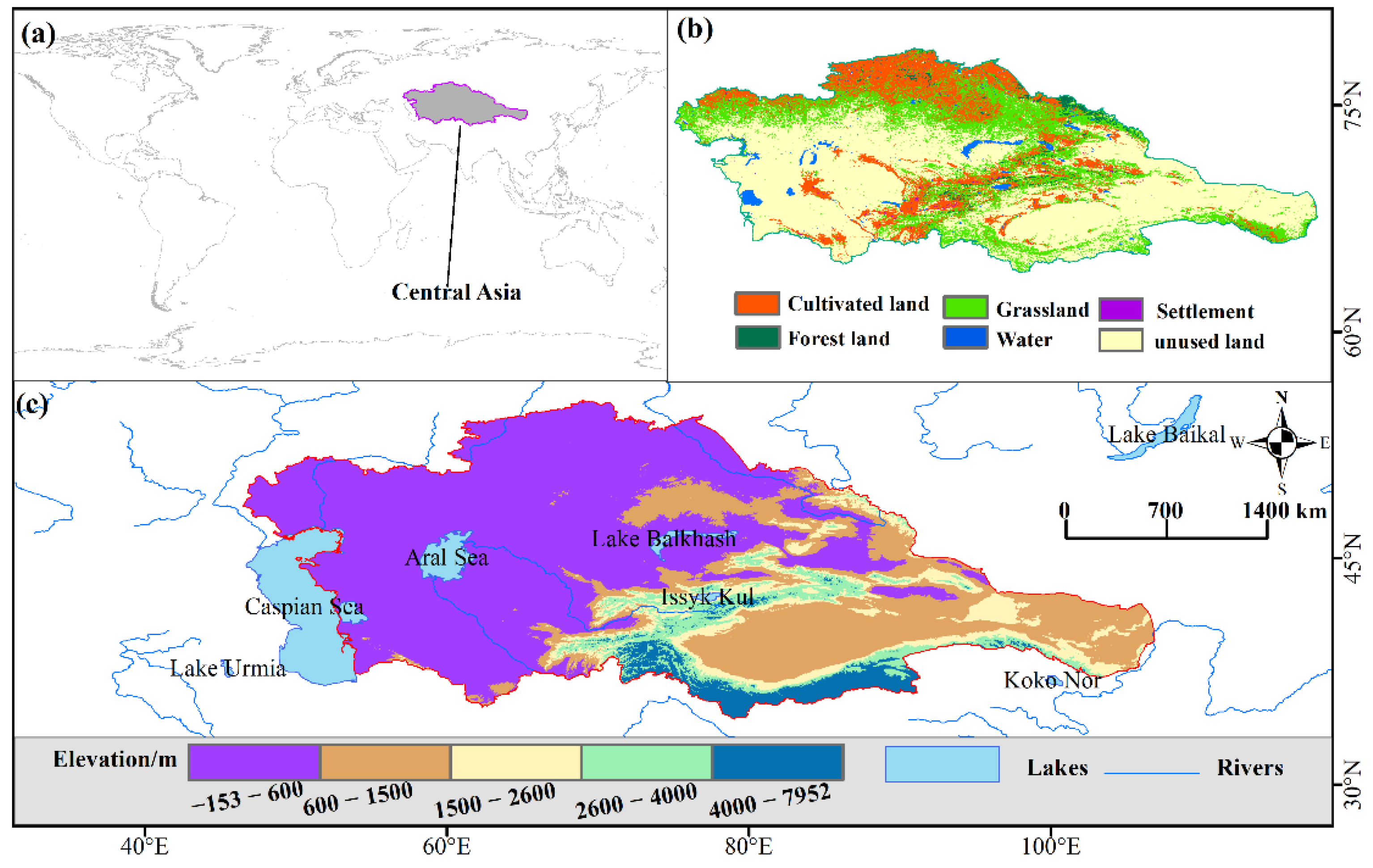
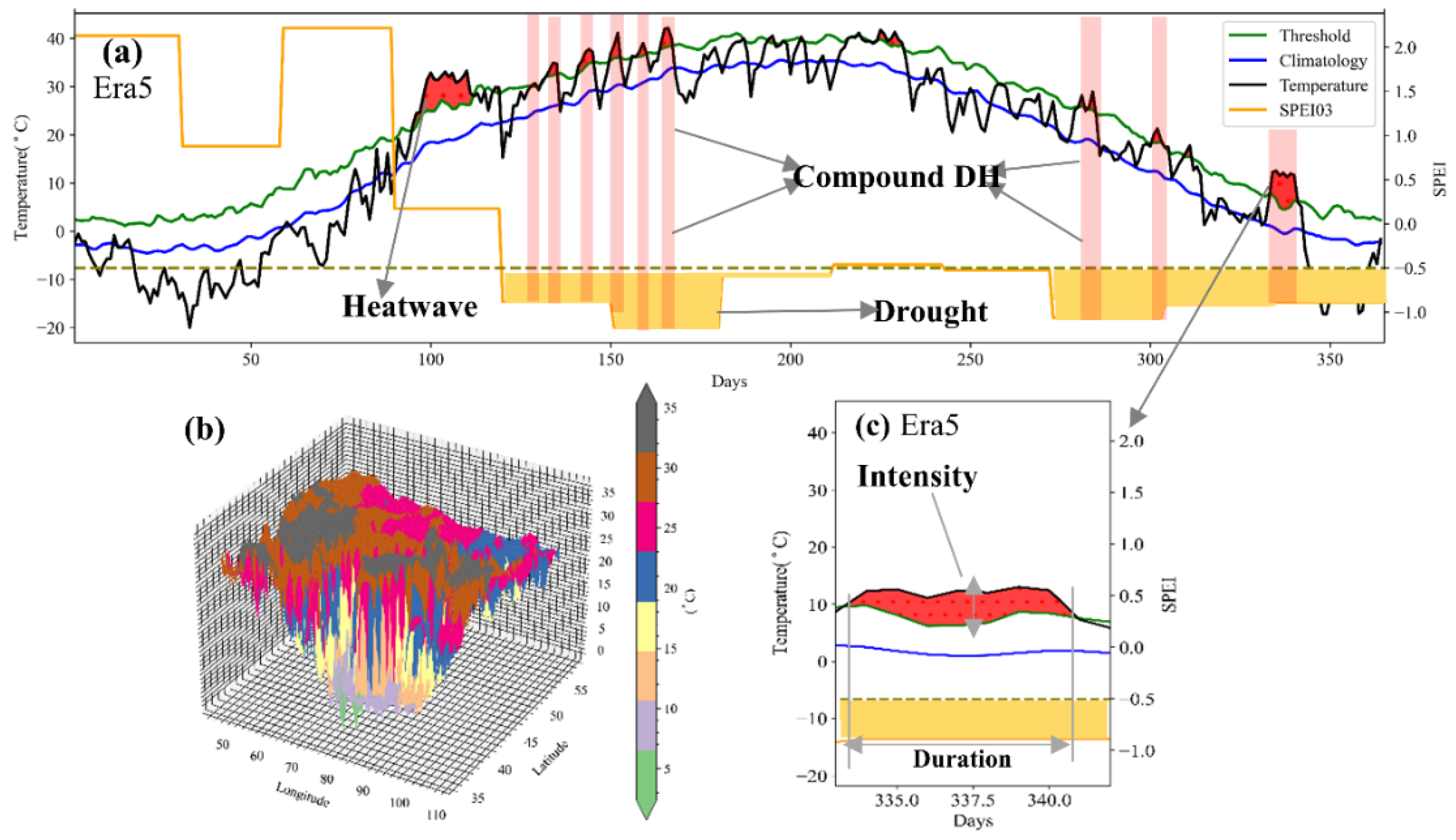


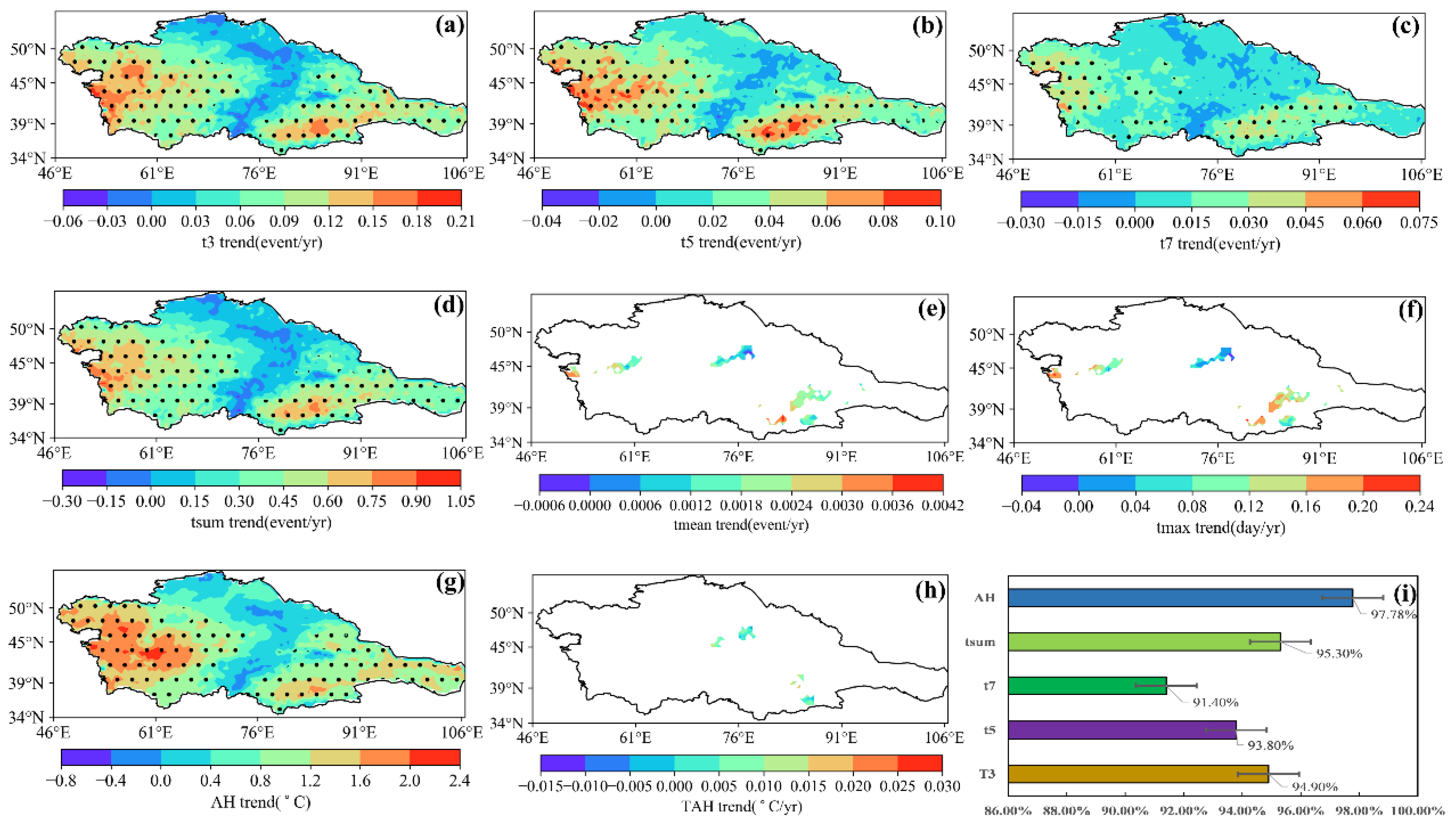
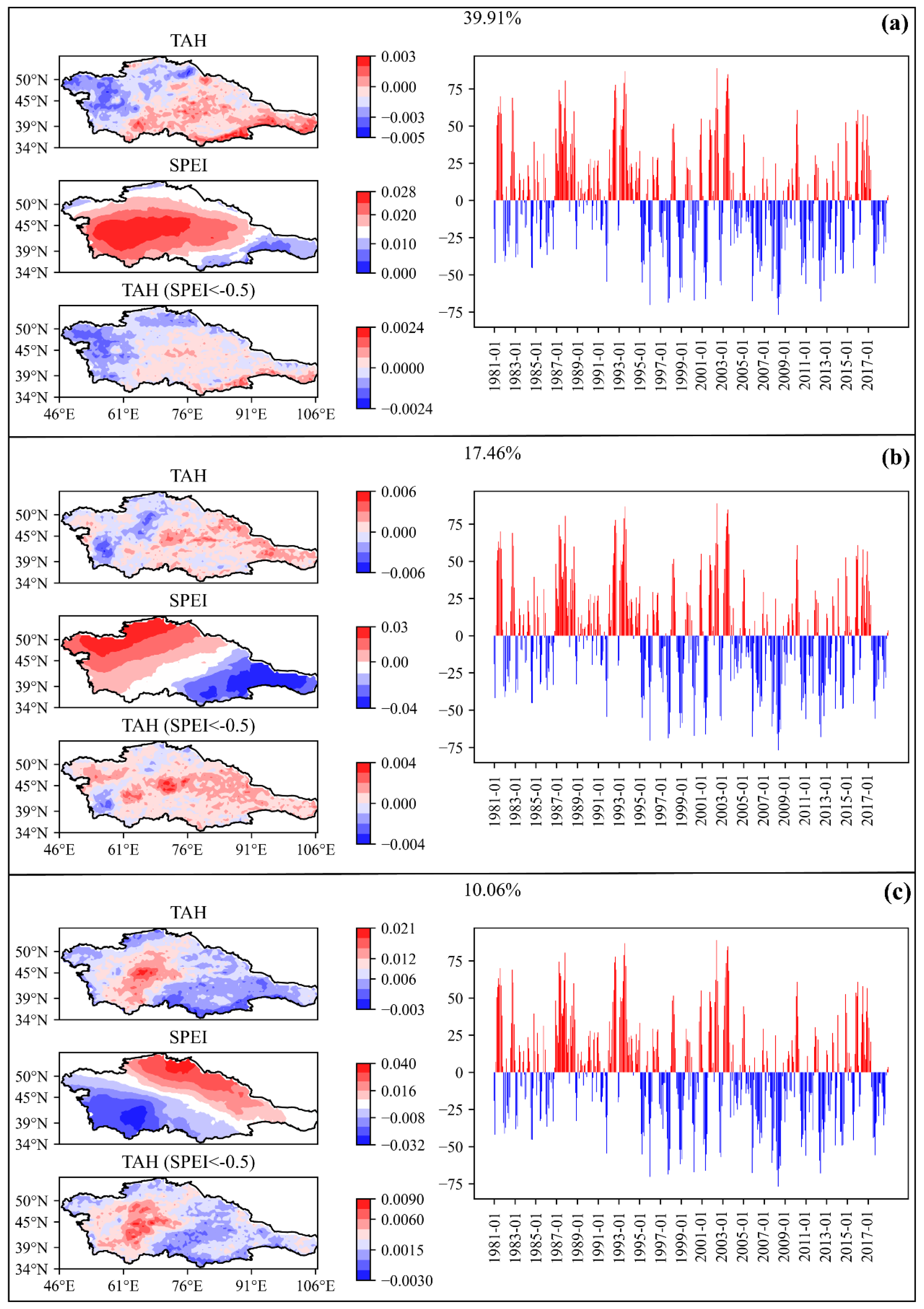

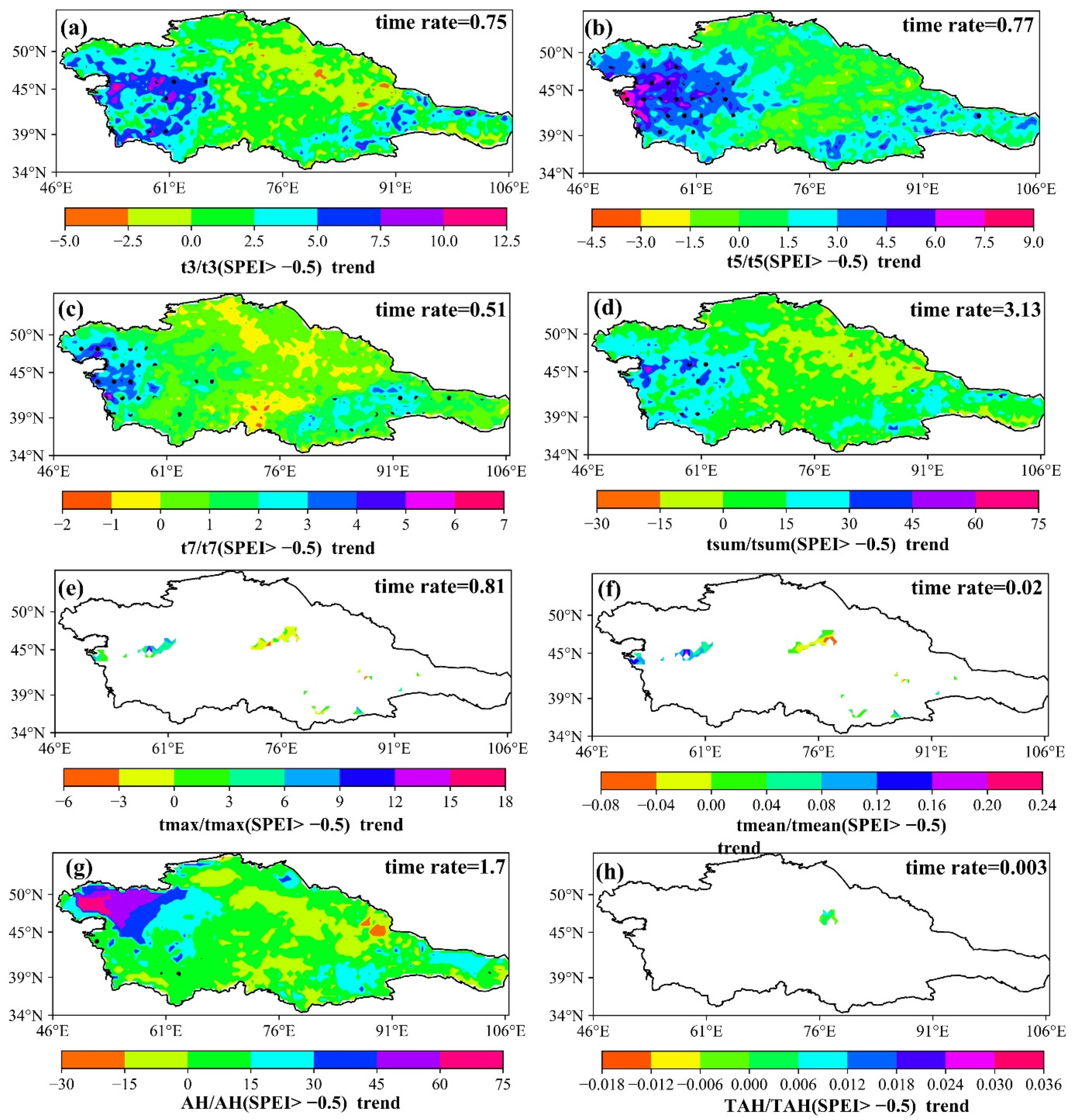
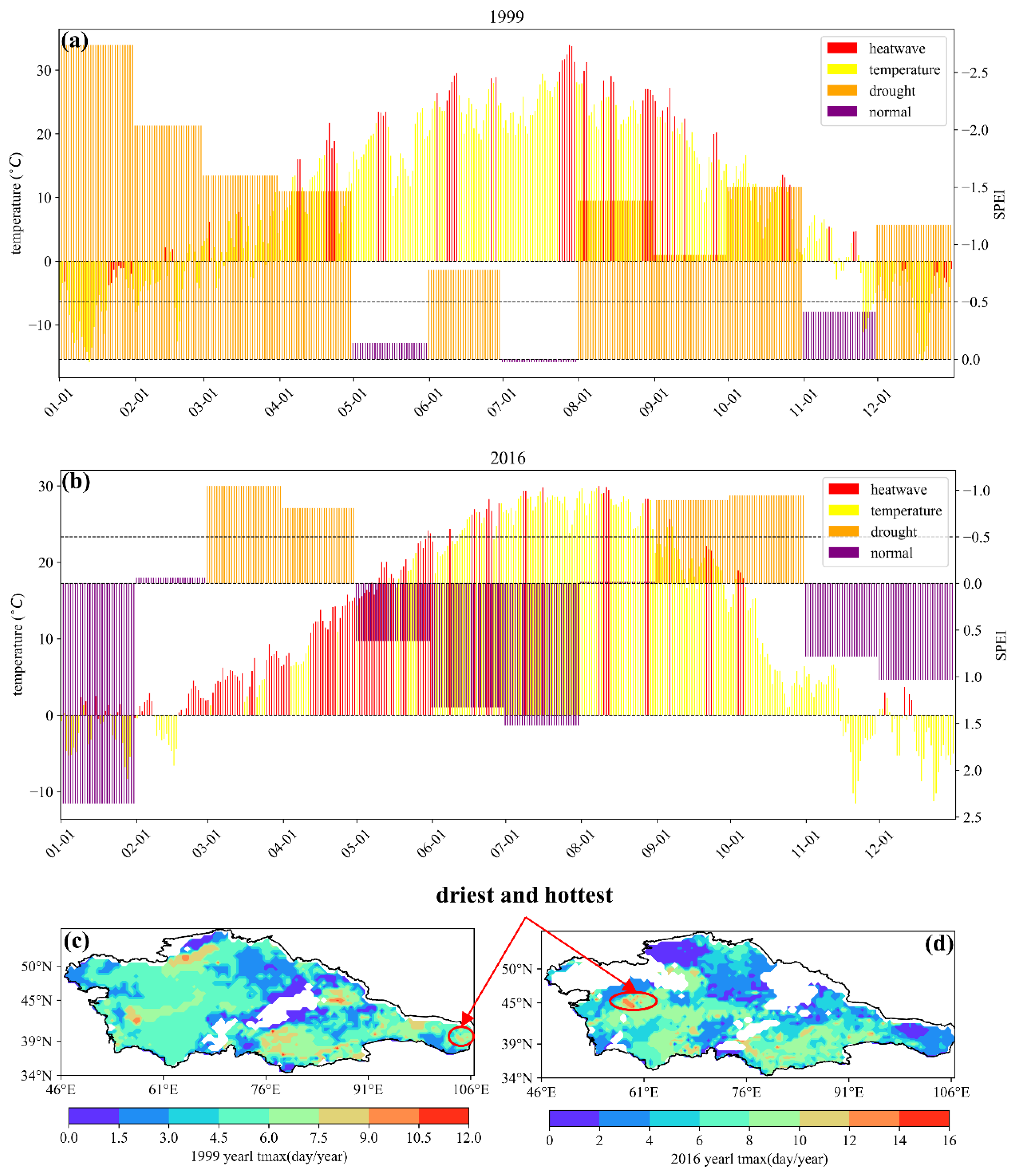
| Days | Average | |
|---|---|---|
| 1999_Wet | 18 14 15 24 11 13 7 12 12 27 11 12 | 14.67 |
| 1999_Dry | 11 25 11 9 15 | 4.73 |
| 2016_Dry | 4 8 6 | 6 |
| 2016_Wet | 8 10 4 6 8 8 7 7 | 7.25 |
| CDHWs | Heatwaves | Droughts | CDHWs/Heatwaves | CDHWs/Droughts | |
|---|---|---|---|---|---|
| 1999 | 39 | 58 | 273 | 67.27% | 14.29% |
| 2016 | 52 | 123 | 122 | 42.28% | 42.62% |
Publisher’s Note: MDPI stays neutral with regard to jurisdictional claims in published maps and institutional affiliations. |
© 2022 by the authors. Licensee MDPI, Basel, Switzerland. This article is an open access article distributed under the terms and conditions of the Creative Commons Attribution (CC BY) license (https://creativecommons.org/licenses/by/4.0/).
Share and Cite
Wang, C.; Li, Z.; Chen, Y.; Li, Y.; Liu, X.; Hou, Y.; Wang, X.; Kulaixi, Z.; Sun, F. Increased Compound Droughts and Heatwaves in a Double Pack in Central Asia. Remote Sens. 2022, 14, 2959. https://doi.org/10.3390/rs14132959
Wang C, Li Z, Chen Y, Li Y, Liu X, Hou Y, Wang X, Kulaixi Z, Sun F. Increased Compound Droughts and Heatwaves in a Double Pack in Central Asia. Remote Sensing. 2022; 14(13):2959. https://doi.org/10.3390/rs14132959
Chicago/Turabian StyleWang, Chuan, Zhi Li, Yaning Chen, Yupeng Li, Xigang Liu, Yifeng Hou, Xuechun Wang, Zulipiya Kulaixi, and Fan Sun. 2022. "Increased Compound Droughts and Heatwaves in a Double Pack in Central Asia" Remote Sensing 14, no. 13: 2959. https://doi.org/10.3390/rs14132959
APA StyleWang, C., Li, Z., Chen, Y., Li, Y., Liu, X., Hou, Y., Wang, X., Kulaixi, Z., & Sun, F. (2022). Increased Compound Droughts and Heatwaves in a Double Pack in Central Asia. Remote Sensing, 14(13), 2959. https://doi.org/10.3390/rs14132959









